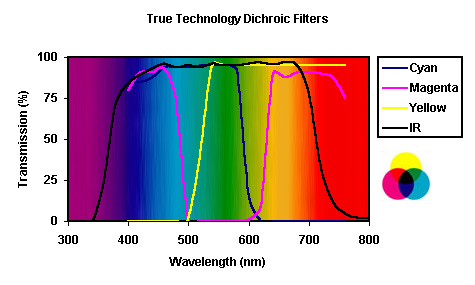

[Picture1]
Spectral Sensitivity Characteristics of ICX098 CCD chip used in the Philips ToUcam.
As can be seen the spectral response of this CCD when used for producing RGB images from splitting from the master colour image will not produce data of the same quality as of the images had been obtained through the proper filters.
The problem lies in that, the response of the chip in Blue and green overlap a great deal at ~475nm. Also, a R leak occurs going far back into the 450nm range. Note that simply using an IR block filter will only help a little to cut the R end of the response down, but the problem still lies in G-B overlap, and the red leak.
This in summary means that the Blue image data is “polluted” with G and R (which is why the surface features remain visible, even when an IR block filter is used.) Also, the G image data is slightly polluted by the Red leak.
In further reviewing the documentation, the way in which the CCD reads the data out also causes problems, as 2 x as much G signal is generated than R or B.
We present one possible solution to this problem below.
[Picture2]
Spectral Sensitivity Characteristics of True Technology CMY filters
Looking at the spectral characteristics of the TT CMY filters, we can “pre-filter” the ICX098 CCD chip with the magenta filter including a suitable IR rejection filter. This will get rid of the band from 500nm to 600nm, and block both the G leak into Blue, and Red leak. Signal lost in R and B would be kept to a minimum.
We can reconstruct a synthetic G from the R and B (with a ratio that can be easily worked out). Since the G frame normally does not contain useful data for Mars, this will help to get better B and R frames using the ToUcam with very minimum modification and hopefully will encourage more submitted images with useful data.
Our final thoughts however, are perhaps while the ToUcam is a superb choice for producing high resolution colour imagery, perhaps the cooled CCD systems with proper filters still very much have the edge when one wishes to produce filtered imagery of Mars.
Best Regards,
Damian Peach
Tan Wei Leong.
ALPO-JAPAN 메일링 그룹에 현재 많은 좋은 사진들을 올리고 있는 영국의 Mr.Damian과 싱카포르의 Mr,Tan Wei Leong씨가 보내온 자료입니다.
ToUcam 사용하시는 분들은 참조하세요...

 디지탈 SLR - 시그마 SD9 리뷰1
디지탈 SLR - 시그마 SD9 리뷰1
 디카의 적외선 감지 능력
디카의 적외선 감지 능력










